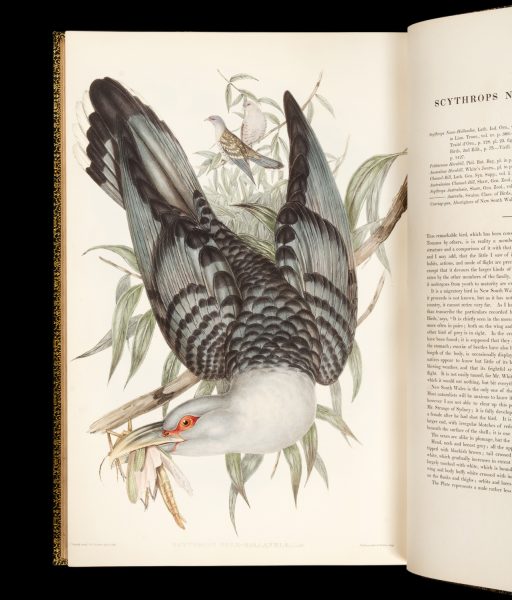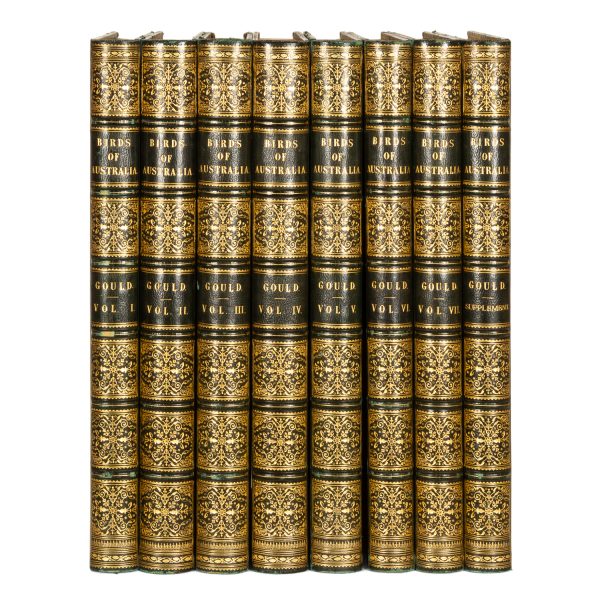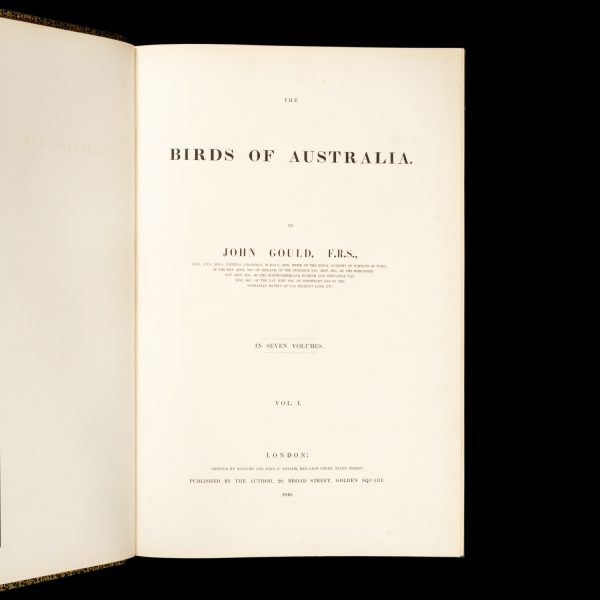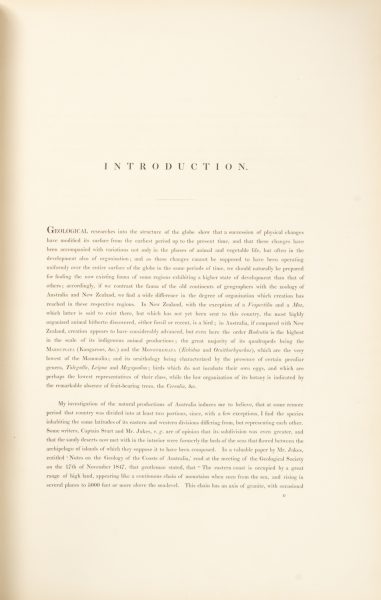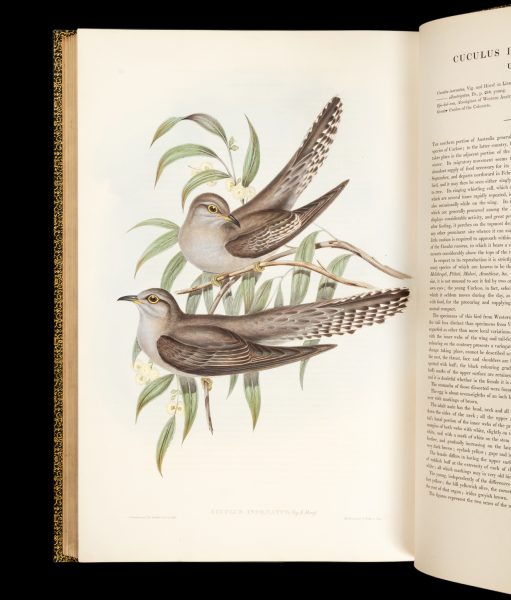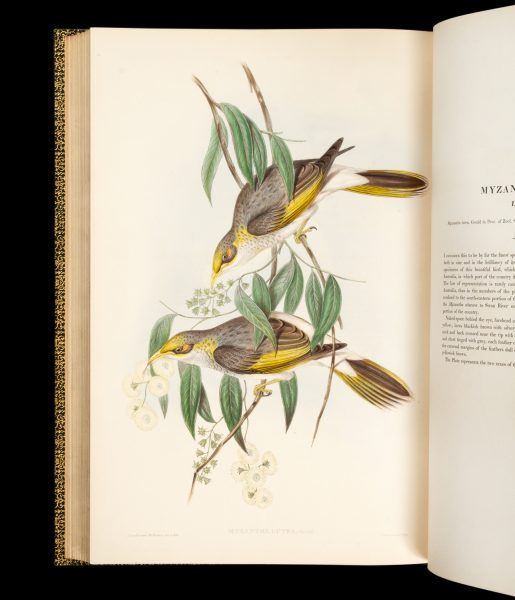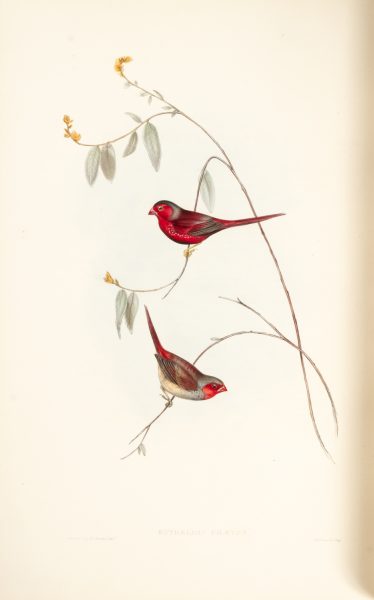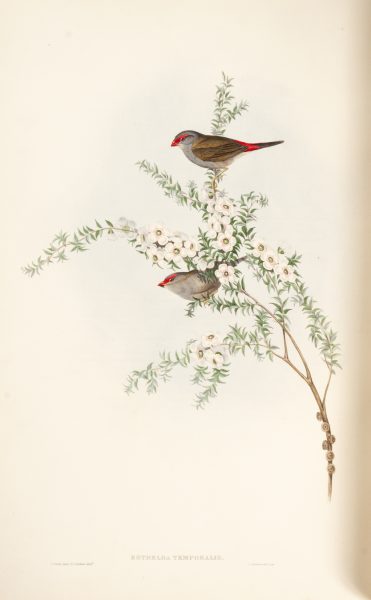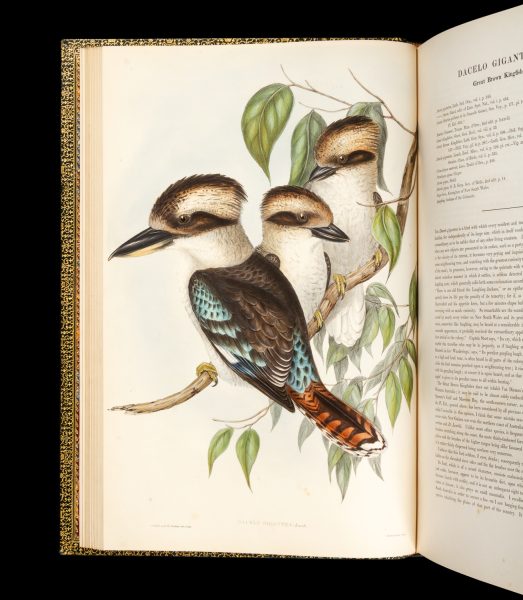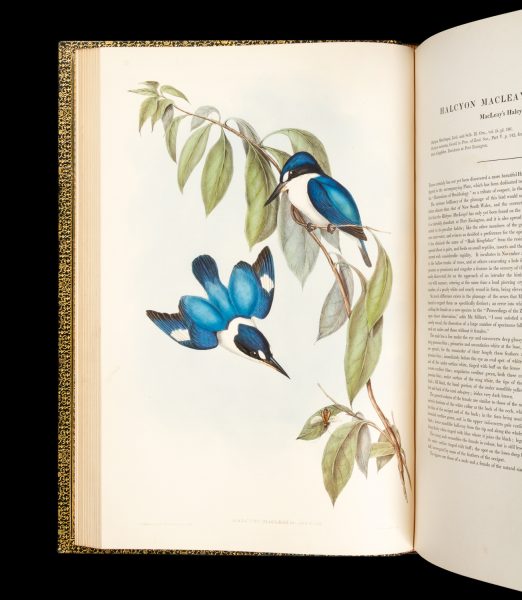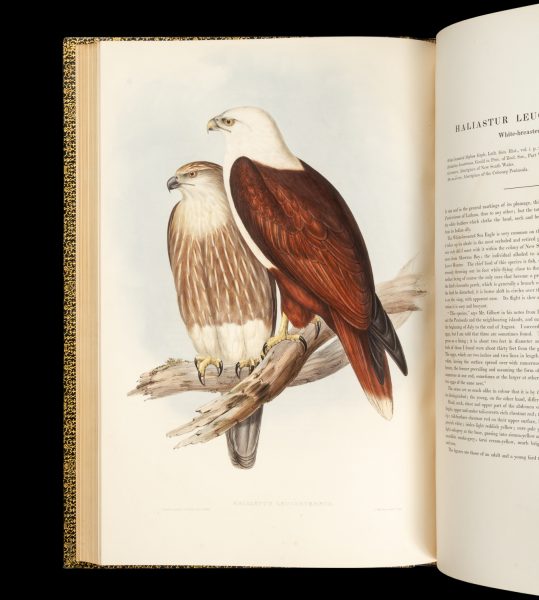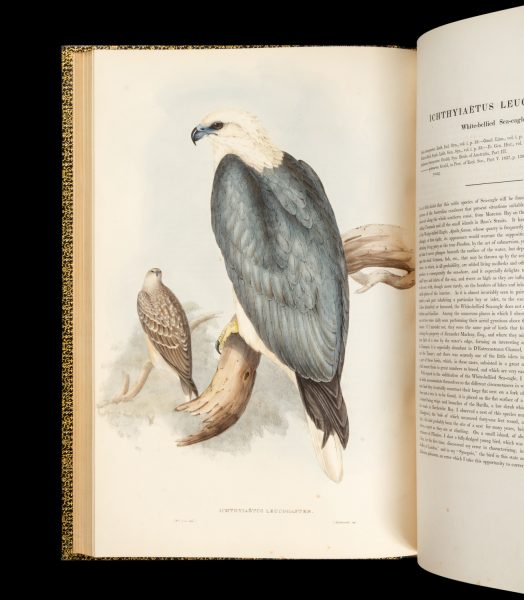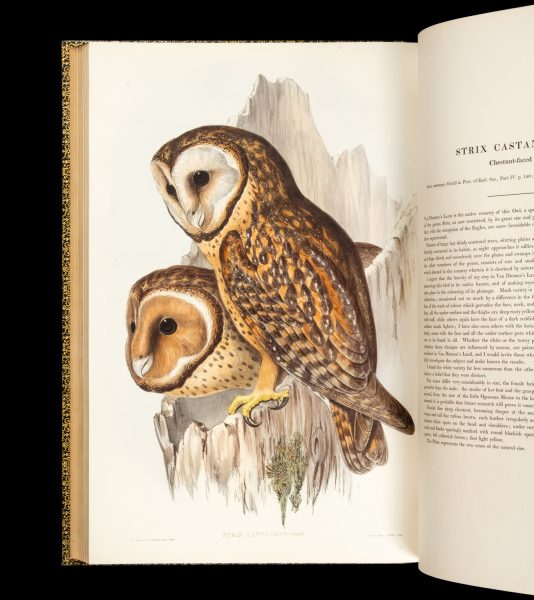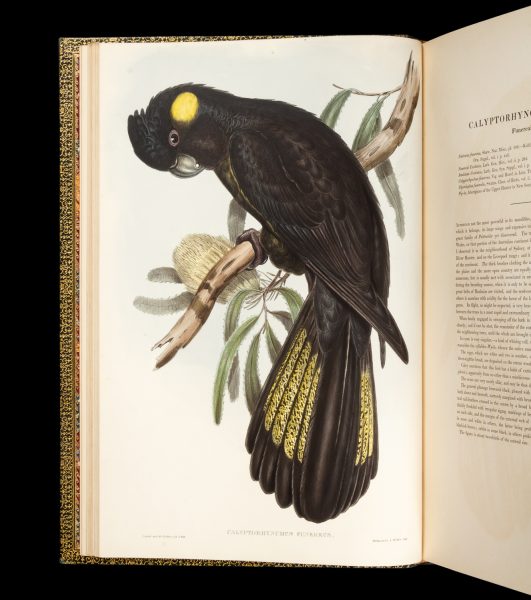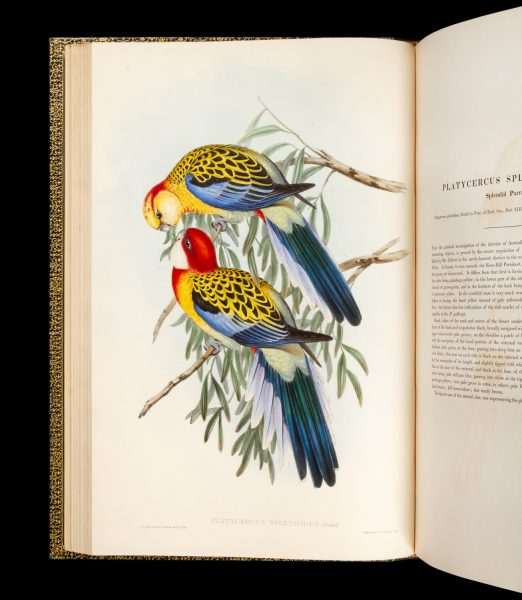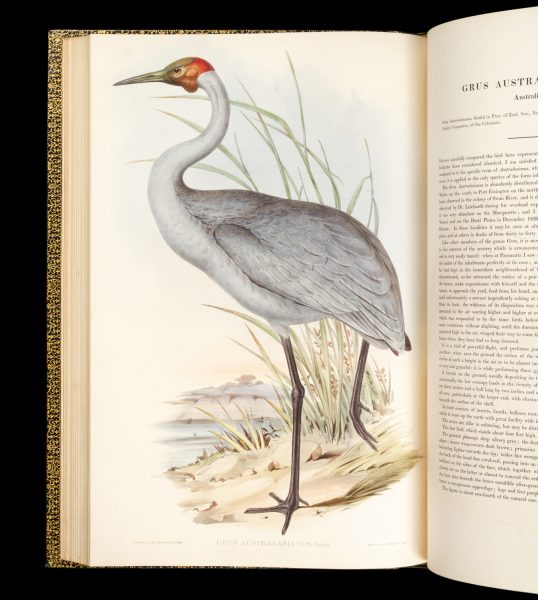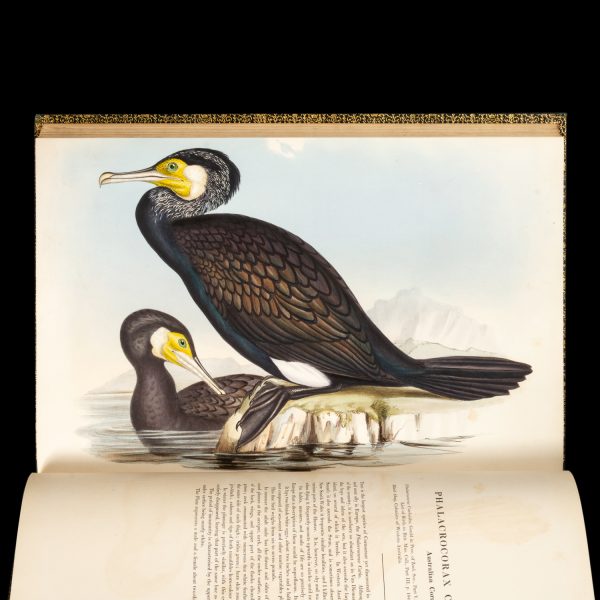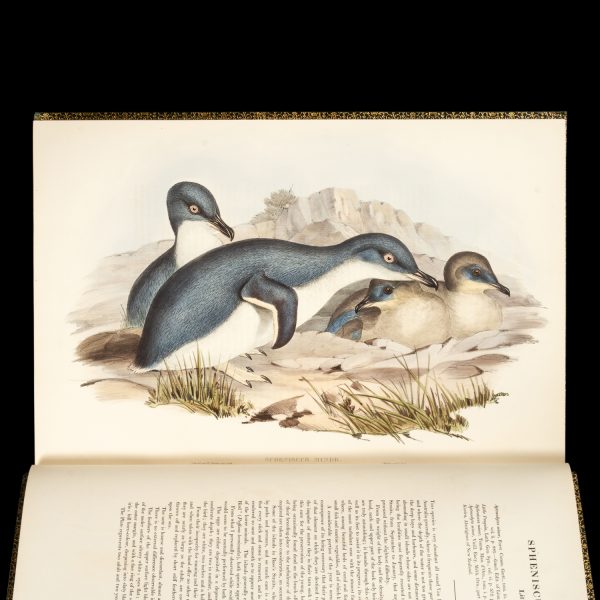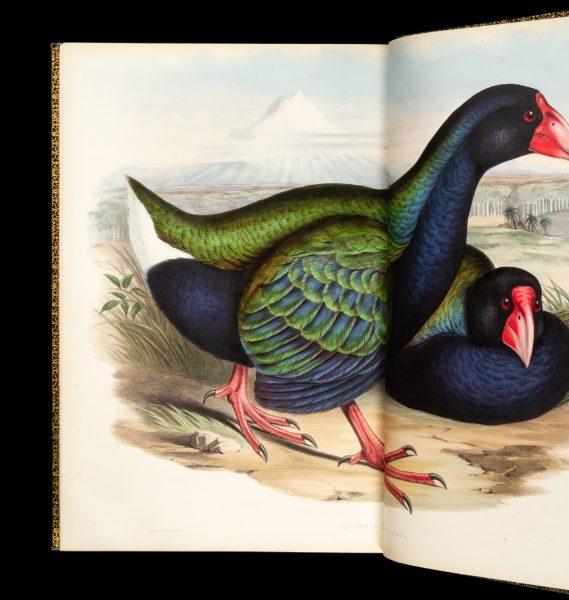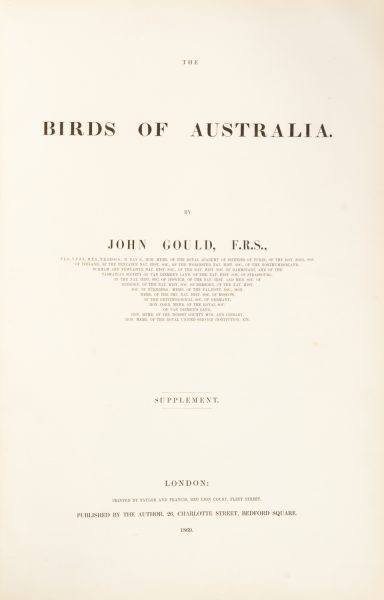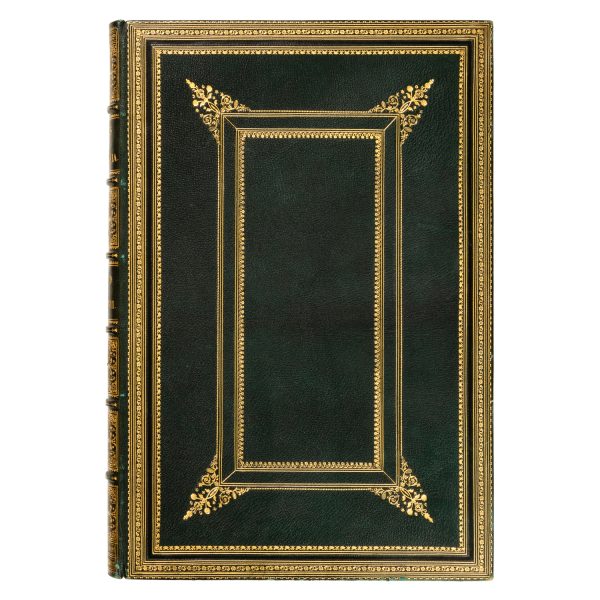# 47089
GOULD, John (1804 - 1881); GOULD, Elizabeth (1804 - 1841); RICHTER, Henry Constantine (1821 - 1902)
The Birds of Australia (complete set)
$750,000.00 AUD
London : printed by Richard and John Taylor for the author, 1848. Seven volumes, imperial folio, finely bound by Sotheran and Co. in full green crushed morocco over boards, elaborate gilt panels and rules, spine in compartments with raised bands, lettered and tooled in gilt (bindings with some light edge rubbing and scuffs); all edges gilt, marbled endpapers, bookplate of Sir Edward Charles Stirling to front pastedowns; Vol. I pp. [vi – Title leaf, Dedication leaf, List of Subscribers]; [xii – General Index]; [v] – xii (Preface); xiii – cii (Introduction); [xiv – Table of the Range of Distribution of the Species]; [ii – List of Plates]; the subsequent volumes with a Title Leaf and List of Plates; containing a total of 600 stone lithographs printed by Hullmandel, coloured by hand, each with tissue guards and an accompanying leaf of descriptive letterpress text. Together with: The Birds of Australia. Supplement. London : printed by Richard and John Taylor for the author, 1869. Imperial folio, in uniform binding, with 81 stone lithographs, coloured by hand; each with an accompanying leaf of descriptive letterpress text. Occasional light foxing, but a clean, vibrant set in a firm and solid binding, an exceptional work with 681 full page hand-coloured lithographs, three of which are double page. Printed in a projected edition of 250 copies (although Wantrup estimates between 220 – 230 were completed), a great number of which have been split for the exquisite original artworks contained within, and with numerous copies held in library collections.
The first comprehensive survey of the birds of Australia, with hand-coloured illustrations and descriptions of 681 species, 328 of which were new to Western science and which Gould was the first to describe.
The finest of all Australian colour plate books, and Gould’s ‘greatest achievement’ (Wantrup).
One of the few complete sets remaining in private ownership.
British ornithologist John Gould was born in 1804. At the age of fourteen he was apprenticed to the Royal Gardens at Windsor, where his father was head gardener. In 1824 he set himself up in business as a taxidermist, and by 1827 had been appointed the first curator and preserver at the museum of the Zoological Society of London. In this position he retained the freedom to conduct his own business, to act as a consultant to private collectors and institutions, and to travel widely in order to obtain specimens.
Having established his reputation as one of Europe’s leading taxidermists, in 1829 Gould married the talented artist Elizabeth Coxen. Together, the Goulds embarked on a series of magnificent and justly celebrated publications on ornithology, which brought together John’s peerless abilities as a natural scientist (he would write virtually all of the descriptions in his books) and Elizabeth’s qualities as a natural history artist of the highest order (she would create most of the lithographs, usually working from her husband’s preparatory drawings). These early publications included A Century of Birds from the Himalaya Mountains (1830-32) and The Birds of Europe (1832-37).
In May 1838 the Goulds travelled to Australia to commence work on their hugely ambitious project, The Birds of Australia, which Gould would later acknowledge as his magnum opus. They spent two years travelling in Tasmania, New South Wales and South Australia, before departing for England in April 1840. As Wantrup notes, ‘Gould’s work in the field was remarkable, collections 800 bird specimens as well as the nests and eggs of more than seventy species, and making extensive field notes and sketches, including a record of the Aboriginal names of many species. In addition, he brought back about seventy mammalian specimens.’ (Wantrup, I, p. 514)
From December 1840 The Birds of Australia was issued in parts at three-month intervals. In August 1841, Elizabeth died shortly before the issue of the fourth part, meaning that her contribution to the publication was limited to 84 plates. Her replacement on the project, Henry Constantine Richter, is responsible for the vast majority of the remaining lithographs (although there were individual plates made by Edward Lear and Benjamin Waterhouse Hawkins). By December 1848, the work had been published in its entirety, comprising 36 parts with a total of 600 superb hand-coloured lithographs, each accompanied by a letterpress description penned by Gould. The Supplement was issued in parts over an extended period, from March 1851 to August 1869. No set of Gould’s The Birds of Australia is regarded as complete without the Supplement.
Subscribers to The Birds of Australia were of course expected to have the folio volumes bound at their own expense: the original parts were issued in plain cloth-backed card or boards. The present set is bound in what had quickly became recognised by the mid 1840s as the ‘Gould’ style of binding: typically, this was a half (or full) green (or dark green) morocco with gilt rule and dentelles, spine in compartments with elaborate gilt tooling, and all edges gilt. This style reflected Gould’s personal taste, as it was the type chosen by Gould for his personal set. (ibid. p.515).
In his analysis of the publication data, Wantrup estimates that in all likelihood between 220 and 230 complete sets of The Birds of Australia were issued, but that of these a large percentage were to institutional subscribers; and, when we take into account the fact that in the intervening century and a half many more sets have either been acquired by institutions or split by print dealers, there can be no question that the number of complete sets remaining in private ownership is very small indeed. (ibid., 516)
Provenance:
Sir Edward Charles Stirling (1848-1919), Australian anthropologist and the first professor of physiology at the University of Adelaide; Honorary Director (1889-1895 and 1913-1914), Director (1895-1913), and Honorary Curator of Ethnology (1914-1919), South Australian Museum, his armorial bookplate with the motto Gang Forward to the front free endpapers.
‘Dr. Edward Charles Stirling, a forceful personality who for 38 years was to play an important part in the progress of the Museum, helping it through one of its more difficult periods, recording noteworthy discoveries and by his enthusiastic efforts vastly increasing the collections.’ – Records of the South Australian Museum, Vol. XII, Adelaide, June 18, 1956.
References:
Anker/Copenhagen 174 and 179; Ayer/Zimmer pp.255 and 259; Fine Bird Books p.101; Nissen IVB 370; Sauer 9 and 18; Whittell pp.287-288; Wood p.365; Wantrup, Australian Rare Books, I, pp. 507





